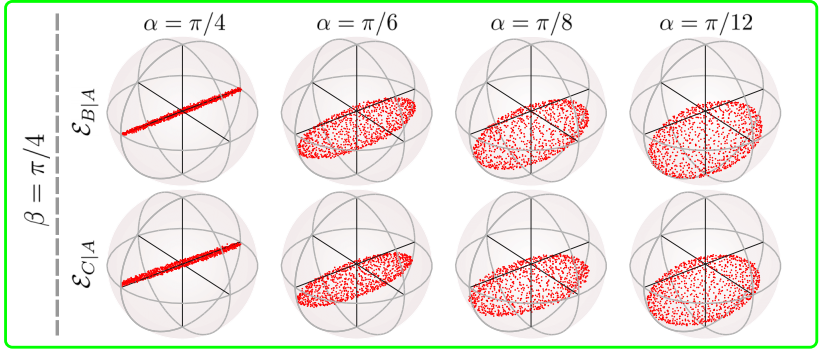A team of USTC researchers led by Prof. GUO Guangcan has made important progress in the research of quantum mechanics. They made the first experimental validation of quantum steering ellipsoids, which shows the ellipsoidal nature of the set of steered states for a variety of two-qubit states, and conducted tests of volume monogamy relations for three-qubit states and mixed entanglement. The paper, titled “Experimental Validation of Quantum Steering Ellipsoids,” was published in Physical Review Letters, 22 February 2019.

Figure 1. Experimental validation of the steering ellipsoids, extracted from the paper by ZHANG et al.
The concept of “steering” a quantum system was first defined by Erwin Schrödinger. In modern language, if two observers, say Alice and Bob, share an entangled pure state, then Alice can steer Bob’s system to any desired state by making measurements. This was a generalization of the result in a paper written by Einstein, Podolsky, and Rosen (EPR), who described the connection as “spooky action at a distance”.

Figure 2. Spooky action, credit: brilliant.org
Nowadays, there is substantial interest in the case that the observers do not share a pure state. Thus, entanglement is no longer sufficient for one party to steer the other to any desired state. This comes with several important questions, like, to which states can Alice steer Bob’s systems? For a multiparty state, are there restrictions on the degree to which one party can steer others?
It’s predicted that the set of all qubit states that can be steered to by measurements forms an ellipsoid in the Bloch ball, that is, the “quantum steering ellipsoid”. This will serve as a simple visual characterization of the initial two-qubit state, and a geometric reflection of various aspects of entanglement. The USTC team experimentally verified these properties via measurements on different polarization-entangled photonic qubit states.
Moreover, for pure three-qubit states, the team verified the predictions that two quantum steering ellipsoids generated by measurements on the first qubit are to satisfy a monogamy relation, stronger than the well-known monogamy of entanglement for concurrence. They also found that this monogamy relation may be violated by a mixed entangled state, which satisfies a weaker monogamy relation nevertheless.
The validation demonstrated the ellipsoidal nature of the set of steered states for a variety of two-qubit states, and thus will lead both theoretical and experimental interests to investigate whether the natures are still valid in more general scenarios. It’s also noteworthy that the steering ellipsoids do not rely on the selection of reference frames, which implies that the ellipsoids provide a powerful method to characterize quantum correlations of the system without shared reference frames, possibly leading further applications in the future quantum networks.
The first author of the paper is ZHANG Chao, post-doc of the Key Laboratory of Quantum Information, USTC, CAS. The work received support from the Ministry of Sci. and Tech. of China, National Natural Science Foundation of China, Chinese Academy of Sciences, and Anhui Province.
For further reading, search “Quantum steering, entanglement and Bell nonlocality, Frederick Denis Vas”.
(Written by QIANG Jiaxuan, edited by SHI Xiao, USTC News Center.)